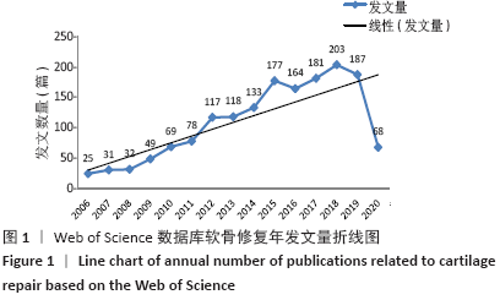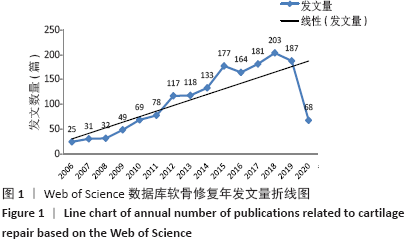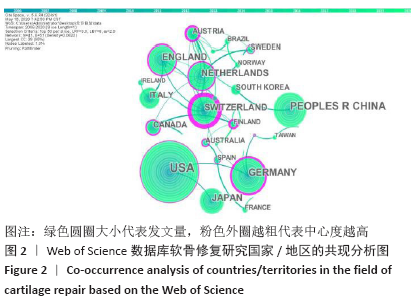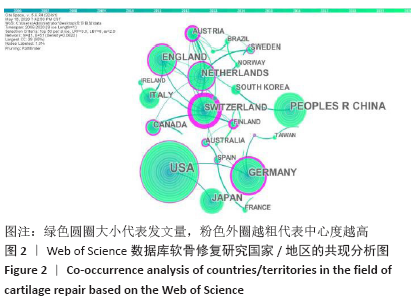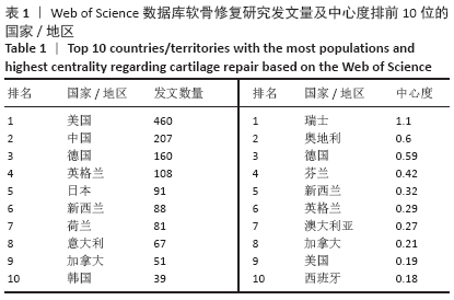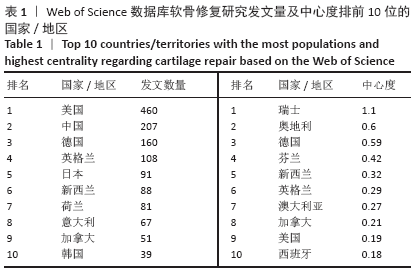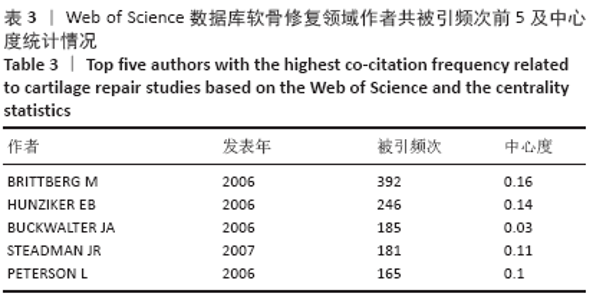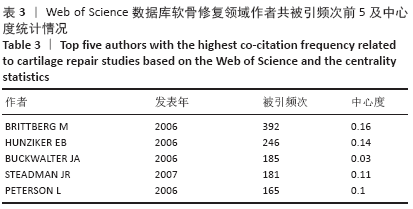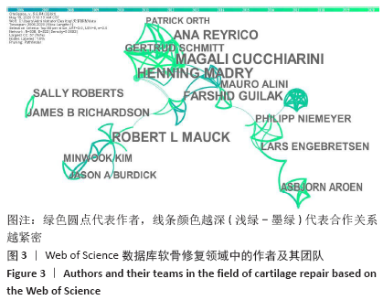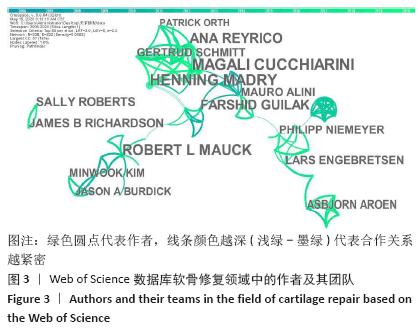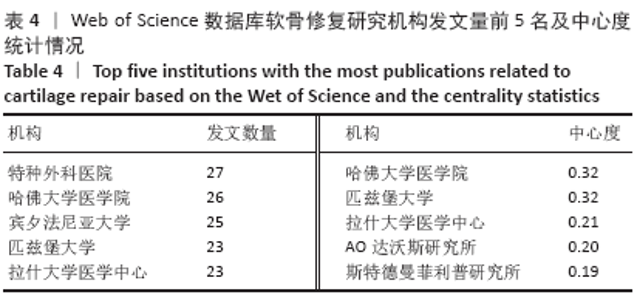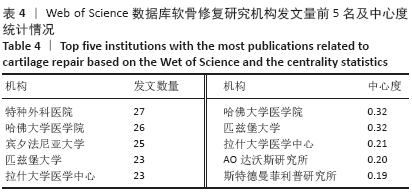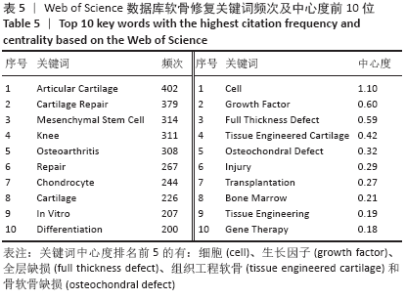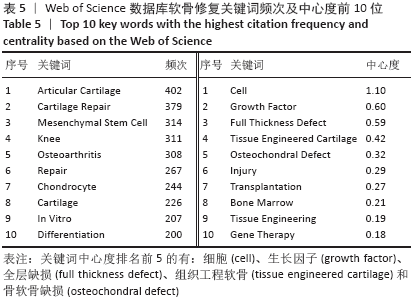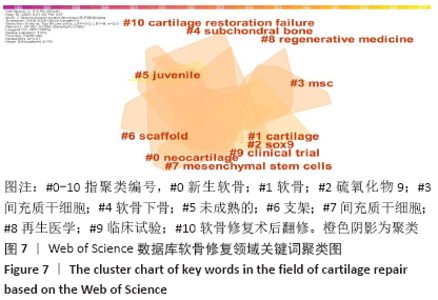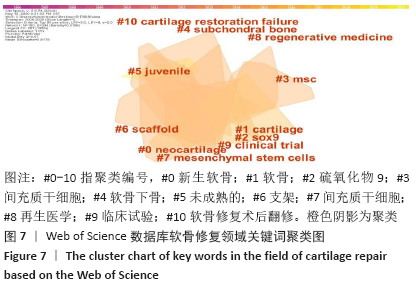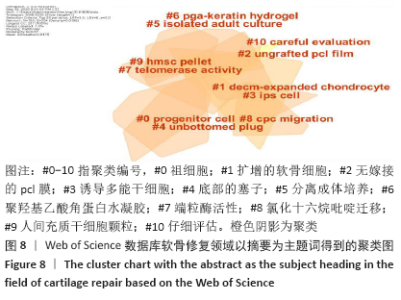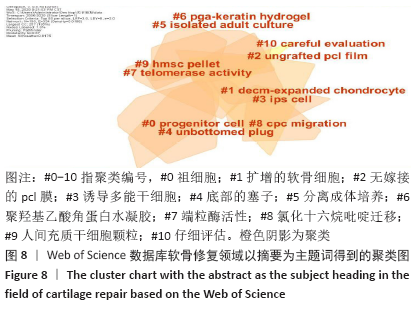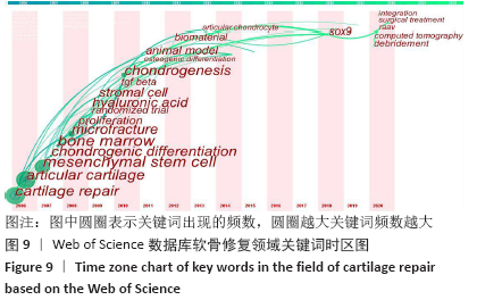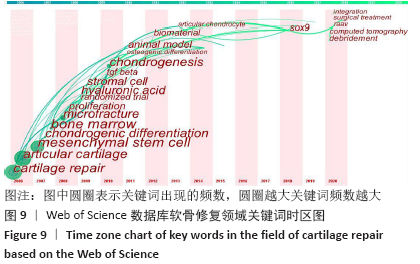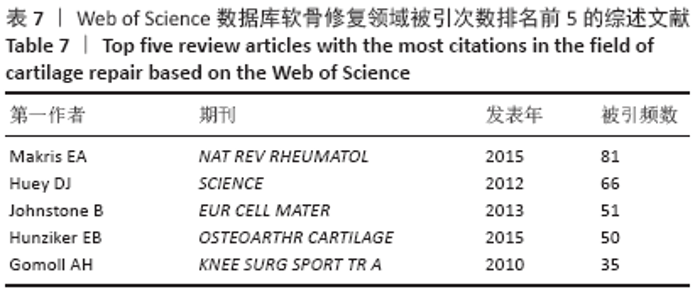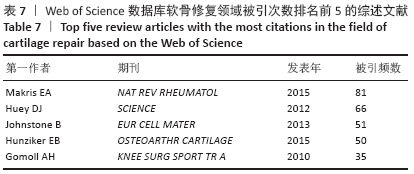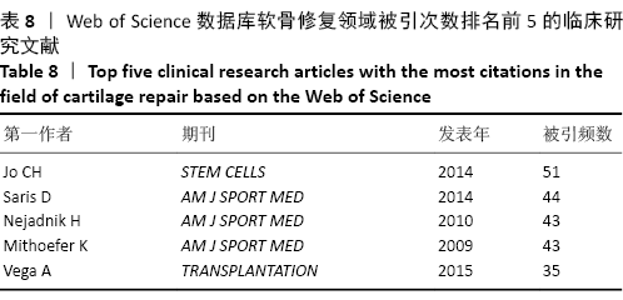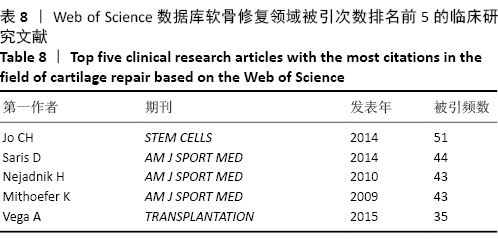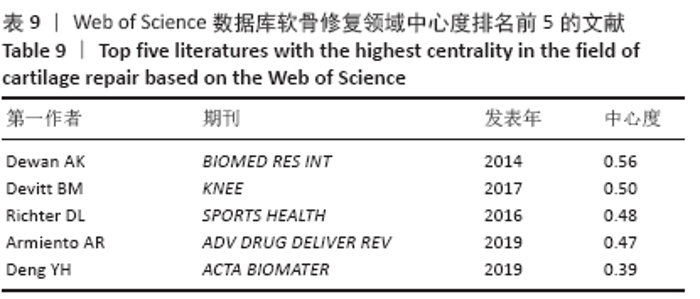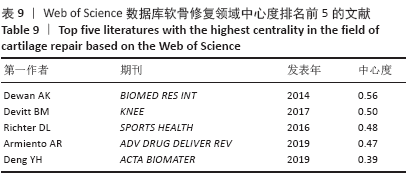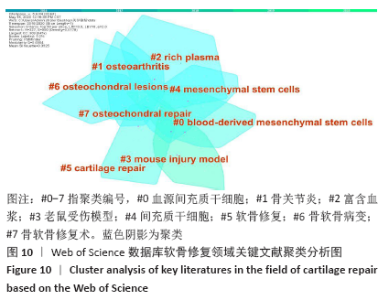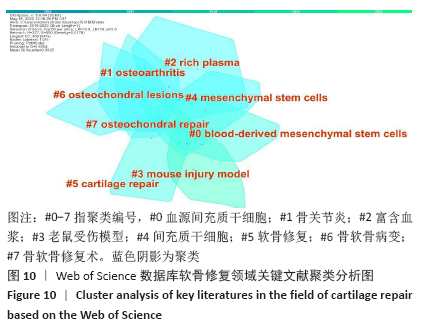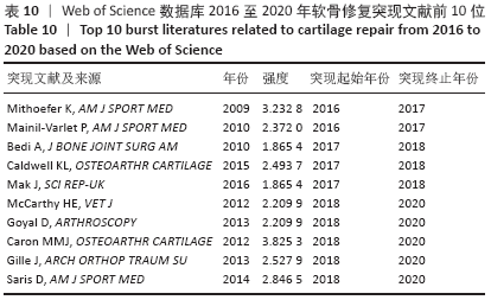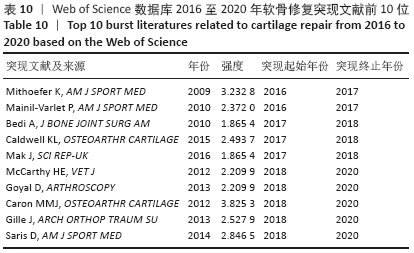Chinese Journal of Tissue Engineering Research ›› 2021, Vol. 25 ›› Issue (17): 2657-2663.doi: 10.3969/j.issn.2095-4344.3191
Previous Articles Next Articles
Bibliometric and visual analysis of literature on cartilage repair in the Web of Science in recent 15 years
Wen Shuaibo, Han Jie, Wu Yukun
- Department of Joints and Sports Medicine, Ruikang Hospital Affiliated to Guangxi University of Chinese Medicine, Nanning 530011, Guangxi Zhuang Autonomous Region, China
-
Received:2020-05-06Revised:2020-05-11Accepted:2020-05-30Online:2021-06-18Published:2021-01-08 -
Contact:Han Jie, Master, Associate chief physician, Department of Joints and Sports Medicine, Ruikang Hospital Affiliated to Guangxi University of Chinese Medicine, Nanning 530011, Guangxi Zhuang Autonomous Region, China -
About author:Wen Shuaibo, Master candidate, Department of Joints and Sports Medicine, Ruikang Hospital Affiliated to Guangxi University of Chinese Medicine, Nanning 530011, Guangxi Zhuang Autonomous Region, China -
Supported by:Appropriate Medical and Health Technology Development and Promotion Application Project of Guangxi, No. S2019070 (to HJ); “Qihuang Engineering” High-level Talent Team Training Project of Guangxi University of Chinese Medicine, No. 04B1804804 (to HJ); Guangxi University Young and Middle-aged Teachers' Basic Research Ability Improvement Project, No. 2020KY07017 (to HJ)
CLC Number:
Cite this article
Wen Shuaibo, Han Jie, Wu Yukun. Bibliometric and visual analysis of literature on cartilage repair in the Web of Science in recent 15 years[J]. Chinese Journal of Tissue Engineering Research, 2021, 25(17): 2657-2663.
share this article
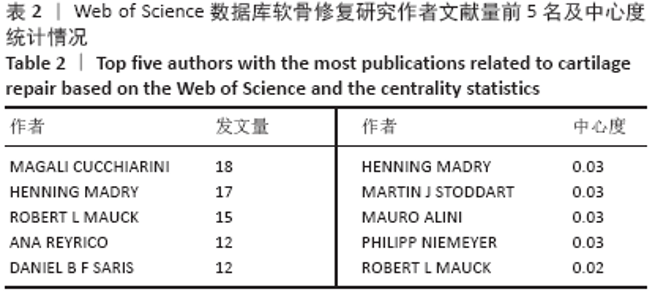
2.3 作者可视化分析 应用Citespace软件对文献作者进行共现图谱分析,时间分区设置为1年分区法,形成的图片上每1个点都代表1位作者。发文量排名前5的作者,见表2。其中MAGALI CUCCHIARINI以18篇排名首位。发文量排名2-5位的作者分别为:HENNING MADRY(17篇),ROBERT L MAUCK(15篇),ANA REYRICO(12篇)和DANIEL B F SARIS(12篇)。共被引作者排名前5的分别有:BRITTBERG M(392次),HUNZIKER EB(246次),BUCKWALTER JA(185次)、STEADMAN JR(181次)和PETERSON L(165次),见表3。在作者合作关系方面,HENNING MADRY和ROBERT L MAUCK均在排名的前5位,还存在分别以PHILIPP NIEMEYER,JAMES B RICHARDSON,FARSHID GUILAK,MAURO ALINI,ASBJORN AROEN等学者为核心的小范围内合作研究,见图3。"
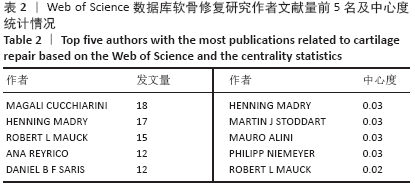
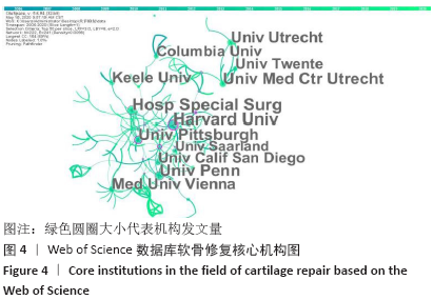
2.4 机构研究可视化分析 以机构为网络节点,对纳入研究的机构进行统计分析,绘制研究机构合作知识图谱,共有由222个节点、241条连线组成,见图4。主要是各医学院校的研究机构以及附属医院,软骨修复研究数量排在前5的机构,其中纽约特种外科医院(Hosp Special Surg)以27篇排名首位,排名2-5位的机构依次为:哈佛大学医学院(Harvard Med School)、宾夕法尼亚大学(Unversity of Pennsylvania)、匹兹堡大学(University of Pittsburgh)和拉什大学医学中心(Univ Med Ctr Utrecht)。排名前5的机构发文量占全球研究总数的大部分,均来自美国。在中心度排名前5的机构依次是哈佛大学医学院、匹兹堡大学、拉什大学医学中心、AO达沃斯研究所和斯特德曼菲利普研究所,见表4。 "
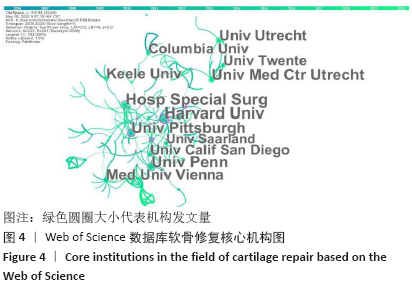
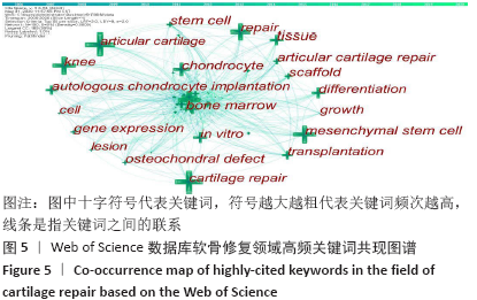
综合Citespace软件分析得出的作者和机构图谱来看,美洲地区在软骨修复领域影响力最大,以医疗技术发达的美国为主,发文数量主要集中在医学院校和研究机构。其次,在软骨修复的研究上,中国地区和欧洲地区的发文量也占有很大比重,综上所述,利用Citespace软件对导入文献的各个部分进行拆分整合,这种分析有一定的局限性,但是从整体分析上看,大数据分析的系统性、科学性和前瞻性更强。 2.5 关键词共现及聚类分析结果 应用Citespace软件对软骨修复的相关文献进行关键词共现分析,见图5。从2006年到2020年图谱显示高频关键词显示,关节软骨articular cartilage排在首位,出现了402次,其次是软骨修复(cartilage repair)和间充质干细胞(mesenchymal stem cell)分别为379和314次。关键词中心度排名前5的有:细胞(cell)、生长因子(growth factor)、全层缺损(full thickness defect)、组织工程软骨(tissue engineered cartilage)和骨软骨缺损(osteochondral defect),见表5。 "
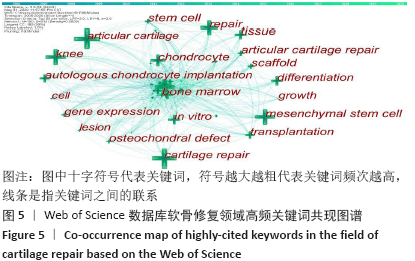
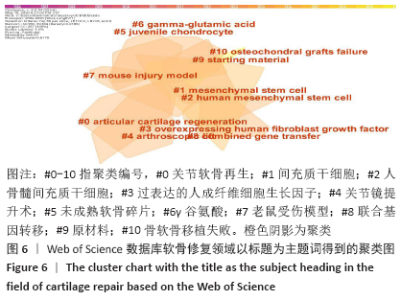
应用Citespace中LLR算法分别对软骨修复相关文献的关键词进行聚类分析得出3个聚类图,见图6-8。此3个聚类的结果均表示研究的前沿领域: (1) 标题主题词聚类结果包括:关节软骨再生(articular cartilage regeneration)、关节软骨细胞培养(co-cultured articular chondrocyte)、人骨髓间充质干细胞(human mesenchymal stem cell)、过表达的人成纤维细胞生长因子(overexpressing human fibroblast growth factor)、关节镜提升术(arthroscopic lift)、未成熟软骨碎片(juvenile chondral fragment)、γ谷氨酸(gamma-glutamic acid)、关节腔内给药(intra-articular delivery)、联合基因转移(combined gene transfer)、老鼠受伤模型(mouse injury model) 和骨软骨移植失败(osteochondral grafts failure)。 (2) 关键词聚类结果提示:新生软骨(neocartilage)、软骨(cartilage)、硫氧化物9(sox9)、间充质干细胞(mesenchymal stem cells)、软骨下骨(subchondral bone)、未成熟的(juvenile)、支架(scaffold)、再生医学(regenerative medicine)、临床试验(clinical trialclinical trial) 和软骨修复术后翻修(revision cartilage restoration)。 (3) 摘要主题词聚类结果得到:祖细胞(progenitor cell)、扩增的软骨细胞 (decm-expanded chondrocyte)、无嫁接的聚已内酯膜(ungrafted pcl film)、诱导多能干细胞(IPS cell)、聚羟基乙酸角蛋白水凝胶(pga-keratin hydrogel)、端粒酶活性(telomerase activity)、氯化十六烷吡啶迁移(cpc migration)、人间充质干细胞颗粒(hmsc pellet)和详细评估(careful evaluation)。 "
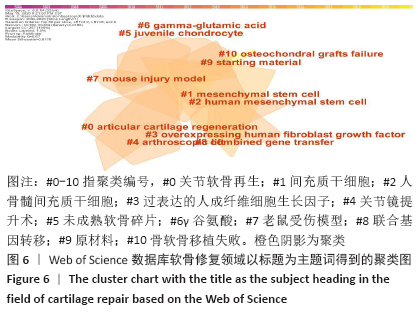
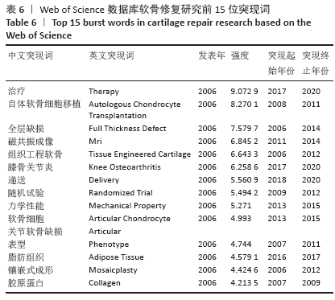
2.6 关键词突现及时区图分析 突现是指一个变量在短期内发生突然的改变,通过Citespace软件的突现检测共得出36个突现词,文中只列举出突现强度前15位关键词,见表6。时区图分析可以发现每个时间段的关键词,以预测每个时间段的研究热点,见图9。通过突现分析和时区图分析发现,软骨修复的研究大概可以分为3个关键时间段: ①2006至2010年:镶嵌式成形(mosaicplasty)、胶原蛋白(collagen)、表型(phenotype)、关节软骨缺损(articular cartilage defect)、随机试验(randomized trial)、组织工程软骨(tissue engineered cartilage)、全层缺损(full thickness defect)、自体软骨细胞(autologous chondrocyte)、自体软骨细胞移植 (autologous chondrocyte transplantation);②2011至2015年:力学性能(mechanical property)、软骨细胞(articular chondrocyte)、磁共振成像(Mri);③2016至2020年:治疗(therapy)、膝骨关节炎(knee osteoarthritis)、脂肪组织(adipose tissue)、硫氧化物(SOX9)、重组腺相关病毒(RAAV)、矢量分析(vector)、计算机断层扫描(computed tomography)和诊断(integration)等。"
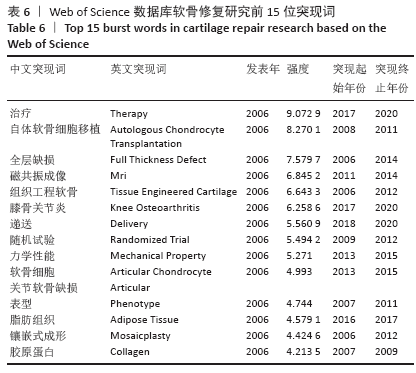
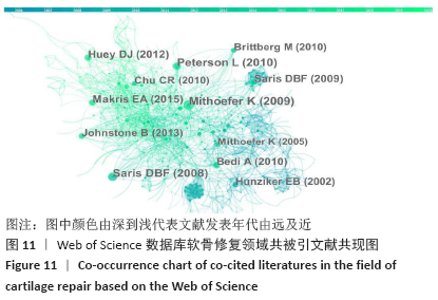
图10显示当前软骨修复的研究主题可分为8大类。其中包含文献较多的3类的聚类标签分别是“blood-derived mesenchymal stem cells(血源间充质干细胞)”、“osteoarthritis(骨关节炎)”以及“rich plasma(富含血浆)”提示其为当前的热点主题。 2.8 研究发展趋势和潜在研究热点 文献共被引共现及突现性分析结果显示,见图11,表10。共有29篇文献具有突现性。按照突现性的时间分布,从2016至2020年出现的突现共被引文章有15篇,文中列举了比较有代表性的文章,文献共被引分析结果表明,在综述类文章方面,MAKRIS EA发表的“关节软骨的修复和组织工程技术”(Repair and tissue engineering techniques for articular cartilage)被引频次为81,此外,在临床研究类文章方面,JO CH发表的“关节内注射间充质干细胞治疗膝关节骨性关节炎:一个概念验证的临床试验”(Intra-Articular Injection of Mesenchymal Stem Cells for the Treatment of Osteoarthritis of the Knee: A Proof-of-Concept Clinical Trial)被引用51次。详见表10。 "
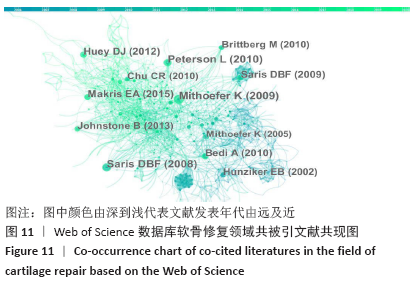
| [1] LORIES RJ, LUYTEN FP. The bone-cartilage unit in osteoarthritis. Nat Rev Rheumatol. 2011;7(1):43-49. [2] WIDUCHOWSKI W, WIDUCHOWSKI J, TRZASKA T. Articular cartilage defects: study of 25,124 knee arthroscopies. Knee. 2007;14(3):177-182. [3] CHEN C. CiteSpace II: detecting and visualizing emerging trends and transient patterns in scientific literature. J Assoc Inform Sci Tech. 2006; 57(3):359-377. [4] 刘光阳.CiteSpace国内应用的传播轨迹-基于2006-2015年跨库数据的统计与可视化分析[J].图书情报知识,2017(2):60-74. [5] 王娟,陈世超,王林丽,等.基于CiteSpace的教育大数据研究热点与趋势分析[J].现代教育技术,2016,26(2):5-13. [6] LI Z, QIN Y, TIAN Y, et al. Visualization analysis of CiteSpace knowledge map for lumbar disc herniation treated with acupuncture and moxibustion. Zhongguo Zhenjiu. 2017;37(5):545-548. [7] 廖雅娴,何本祥,王纯,等.采用CiteSpace软件对肌腱病研究领域值得关注问题的可视化分析[J].中国组织工程研究,2019,23(23): 3746-3753. [8] 于丹丹,谢雁鸣,廖星,等.基于CiteSpace可视化分析中医药领域脑梗死研究热点和趋势[J].中华中医药杂志,2020,35(2):595-598. [9] 林骞,徐浩.基于CiteSpace软件中医数据挖掘文献的可视化分析研究[J].中国中西医结合杂志,2020,40(1):46-51. [10] 胡佳卉,孟庆刚.基于CiteSpace的中药治疗2型糖尿病知识图谱分析[J].中华中医药杂志,2017,32(9):4102-4106. [11] CUCCHIARINI M, ASEN AK, GOEBEL L, et al. Effects of TGF-β Overexpression via rAAV GeneTransfer on the Early Repair Processes in an Osteochondral Defect Model in Minipigs. Am J Sports Med. 2018; 46(8):1987-1996. [12] VENKATESAN JK, MOUTOS FT, REY-RICO A, et al. Chondrogenic differentiation processes in human bone-marrow aspirates seeded in three-dimensional-woven poly (ɛ-Caprolactone) scaffolds enhanced by recombinant adeno-associated virus-mediated sox9 genetransfer. Hum Gene Ther. 2018;29(11):1277-1286. [13] LOEBEL C, MAUCK RL, BURDICK JA. Local nascent protein deposition and remodelling guide mesenchymal stromal cell mechanosensing and fate in three-dimensional hydrogels. Nat Mater. 2019;18(8):883-891. [14] HEVESI M, KRYCH AJ, SARIS DBF. Treatment of cartilage defects with thematrix-induced autologous chondrocyte implantation cookie cutter technique. Arthrosc Tech. 2019;8(6):e591-e596. [15] MAKRIS EA, GOMOLL AH, MALIZOS KN, et al. Repair and tissue engineering techniques for articular cartilage. Nat Rev Rheumatol. 2015;11(1):23-34. [16] PETERSON L, VASILIADIS HS, BRITTBERG M, et al. Autologous chondrocyte implantation: a long-term follow-up. Am J Sports Med. 2010;38(6):1117-1124. [17] JO CH, LEE YG, SHIN WH, et al. Intra-articular injection of mesenchymal stem cells for the treatment of osteoarthritis of the knee: a proof-of-concept clinical trial. Stem Cells. 2014;32(5):1254-1266. [18] GOBBI A, CHAURASIA S, KARNATZIKOS G, et al. Matrix-induced autologous chondrocyte implantation versus multipotent stem cells for the treatment of large patellofemoral chondral lesions: a nonrandomized prospective trial. Cartilage. 2015;6(2):82-97. [19] RICHTER DL, WASCHER DC, TREME G, et al. Knee articular cartilage repair and restoration techniques: a review of the literature. Sports Health. 2016;8(2):153-160. [20] DEVITT BM, BELL SW, WEBSTER KE, et al. Surgical treatments of cartilage defects of the knee: systematic review of randomised controlled trials. Knee. 2017;24(3):508-517. [21] VEGA A, CANTO FD, ALBERCA M, et al. Treatment of knee osteoarthritis with allogeneic bone marrow mesenchymal stem cells: a randomized controlled trial. Transplantation. 2015;99(8):1681-1690. [22] Huey DJ, HU JC, ATHANASIOU KA, et al. Unlike bone, cartilage regeneration remains elusive. Science. 2012;338(6109):917-921. [23] HUNZIKER EB, LIPPUNER K, SHINTANI N, et al. An educational review of cartilage repair: precepts & practice-myths & misconceptions-progress & prospects. Osteoarthritis Cartilage. 2015;23(3):334-350. [24] CHOI JR, YONG KW,CHOI JY. Effects of mechanical loading on human mesenchymal stem cells for cartilage tissue engineering. J Cell Physiol. 2018;233(3):1913-1928. [25] FORTIER LA, BARKER JU, STRAUSS EJ, et al. The role of growth factors in cartilage repair. Clin Orthop Relat Res. 2011;469(10):2706-2715. [26] GOBBI A, KARNATZIKOS G, SCOTTI C, et al. One-step cartilage repair with bone marrow aspirate concentrated cells and collagen matrix in full-thickness knee cartilage lesions: results at 2-year follow-up. Cartilage. 2011;2(3):286-299. [27] BEDI A, FEELEY BT, WILLIAMS RJ. Management of articular cartilage defects of the knee. J Bone Joint Surg Am. 2010;92(4):994-1009. [28] GUDAS R, GUDAITE A, POCIUS A, et al. Ten-year follow-up of a prospective,randomized clinical study of mosaic osteochondral autologous transplantation versus microfracture for the treatment of osteochondral defects in the knee joint of athletes. Am J Sports Med. 2012;40(11):2499-2508. [29] HARRIS JD, SISTON RA, BROPHY RH, et al. Failures, re-operations, and complications after autologous chondrocyte implantation-a systematic review. Osteoarthritis Cartilage. 2011;19(7):779-791. [30] HUANG BJ, HU JC, ATHANASIOU KA, et al. Cell-based tissue engineering strategies used in the clinical repair of articular cartilage. Biomaterials. 2016;98:1-22. |
| [1] | Pu Rui, Chen Ziyang, Yuan Lingyan. Characteristics and effects of exosomes from different cell sources in cardioprotection [J]. Chinese Journal of Tissue Engineering Research, 2021, 25(在线): 1-. |
| [2] | Min Youjiang, Yao Haihua, Sun Jie, Zhou Xuan, Yu Hang, Sun Qianpu, Hong Ensi. Effect of “three-tong acupuncture” on brain function of patients with spinal cord injury based on magnetic resonance technology [J]. Chinese Journal of Tissue Engineering Research, 2021, 25(在线): 1-8. |
| [3] | Lin Qingfan, Xie Yixin, Chen Wanqing, Ye Zhenzhong, Chen Youfang. Human placenta-derived mesenchymal stem cell conditioned medium can upregulate BeWo cell viability and zonula occludens expression under hypoxia [J]. Chinese Journal of Tissue Engineering Research, 2021, 25(在线): 4970-4975. |
| [4] | Huang Dengcheng, Wang Zhike, Cao Xuewei. Comparison of the short-term efficacy of extracorporeal shock wave therapy for middle-aged and elderly knee osteoarthritis: a meta-analysis [J]. Chinese Journal of Tissue Engineering Research, 2021, 25(9): 1471-1476. |
| [5] | Jiang Yong, Luo Yi, Ding Yongli, Zhou Yong, Min Li, Tang Fan, Zhang Wenli, Duan Hong, Tu Chongqi. Von Mises stress on the influence of pelvic stability by precise sacral resection and clinical validation [J]. Chinese Journal of Tissue Engineering Research, 2021, 25(9): 1318-1323. |
| [6] | Zhang Yu, Tian Shaoqi, Zeng Guobo, Hu Chuan. Risk factors for myocardial infarction following primary total joint arthroplasty [J]. Chinese Journal of Tissue Engineering Research, 2021, 25(9): 1340-1345. |
| [7] | Li Dadi, Zhu Liang, Zheng Li, Zhao Fengchao. Correlation of total knee arthroplasty efficacy with satisfaction and personality characteristics [J]. Chinese Journal of Tissue Engineering Research, 2021, 25(9): 1346-1350. |
| [8] | Wei Wei, Li Jian, Huang Linhai, Lan Mindong, Lu Xianwei, Huang Shaodong. Factors affecting fall fear in the first movement of elderly patients after total knee or hip arthroplasty [J]. Chinese Journal of Tissue Engineering Research, 2021, 25(9): 1351-1355. |
| [9] | Wang Jinjun, Deng Zengfa, Liu Kang, He Zhiyong, Yu Xinping, Liang Jianji, Li Chen, Guo Zhouyang. Hemostatic effect and safety of intravenous drip of tranexamic acid combined with topical application of cocktail containing tranexamic acid in total knee arthroplasty [J]. Chinese Journal of Tissue Engineering Research, 2021, 25(9): 1356-1361. |
| [10] | Peng Zhihao, Feng Zongquan, Zou Yonggen, Niu Guoqing, Wu Feng. Relationship of lower limb force line and the progression of lateral compartment arthritis after unicompartmental knee arthroplasty with mobile bearing [J]. Chinese Journal of Tissue Engineering Research, 2021, 25(9): 1368-1374. |
| [11] | Wang Haiying, Lü Bing, Li Hui, Wang Shunyi. Posterior lumbar interbody fusion for degenerative lumbar spondylolisthesis: prediction of functional prognosis of patients based on spinopelvic parameters [J]. Chinese Journal of Tissue Engineering Research, 2021, 25(9): 1393-1397. |
| [12] | Zhang Shangpu, Ju Xiaodong, Song Hengyi, Dong Zhi, Wang Chen, Sun Guodong. Arthroscopic suture bridge technique with suture anchor in the treatment of acromioclavicular dislocation [J]. Chinese Journal of Tissue Engineering Research, 2021, 25(9): 1417-1422. |
| [13] | Yuan Jiawei, Zhang Haitao, Jie Ke, Cao Houran, Zeng Yirong. Underlying targets and mechanism of Taohong Siwu Decoction in prosthetic joint infection on network pharmacology [J]. Chinese Journal of Tissue Engineering Research, 2021, 25(9): 1428-1433. |
| [14] | Chen Junming, Yue Chen, He Peilin, Zhang Juntao, Sun Moyuan, Liu Youwen. Hip arthroplasty versus proximal femoral nail antirotation for intertrochanteric fractures in older adults: a meta-analysis [J]. Chinese Journal of Tissue Engineering Research, 2021, 25(9): 1452-1457. |
| [15] | Luo Lin, Song Naiqing, Huang Jin, Zou Xiaodong. Review and prospect of international research on preschool children’s movement development assessment: a CiteSpace-based visual analysis [J]. Chinese Journal of Tissue Engineering Research, 2021, 25(8): 1270-1276. |
| Viewed | ||||||
|
Full text |
|
|||||
|
Abstract |
|
|||||
